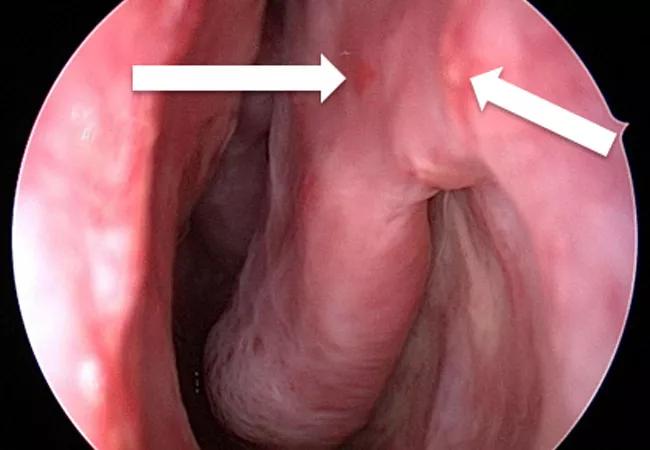Study points to efficacy of two modalities of bevacizumab

Spontaneous, severe nosebleeds can be very distressing for patients. Also known as epistaxis, this symptom is one of the most common complaints in patients with hereditary hemorrhagic telangiectasia (HHT). Persistent epistaxis can severely impact a patient’s quality of life, prompting multiple trips to the ER for nasal packing. Some patients lose so much blood that anemia sets in, prompting physicians to initiate iron and blood transfusions.
Advertisement
Cleveland Clinic is a non-profit academic medical center. Advertising on our site helps support our mission. We do not endorse non-Cleveland Clinic products or services. Policy
To improve quality of life, physicians may try various techniques to keep the lining of the nasal passages moist and healthy. If those prove ineffective, more complex procedures or treatments may be necessary.
To help identify effective medical treatment options, Raj Sindwani, MD, Section Head of Rhinology at Cleveland Clinic, recently participated in a multi-institutional, systematic evidence-based review of research related to the medical treatment of HHT-related nosebleeds. This marked the first study to analyze the outcomes of three different modalities of bevacizumab, a chemotherapy drug used to treat HHT.
“Because we are still grappling with this disease, there’s no gold standard for treatment,” explains Dr. Sindwani, a coauthor of the study. “During our comprehensive literature review, we analyzed how a newer medication could play a role in controlling severe epistaxis, giving patients with HHT more options — but most importantly, more hope.”
HHT is characterized by the formation of mucosal telangiectasias or arteriovenous malformations in various locations throughout the body, including the nose, lungs, liver, brain and gastrointestinal (GI) tract. In the nose, turbulent blood flow often builds within these abnormal blood vessels, causing them to burst.
If initial medical treatments fail to control the nosebleeds, physicians may try cauterization, laser treatment and even stripping off the lining of the nose. “Despite our best efforts to manage telangiectasia, patients often suffer from ongoing issues related to how these blood vessels grow,” reveals Dr. Sindwani.
Advertisement
Bevacizumab is a monoclonal antibody that blocks vascular endothelial growth factor (VEGF), a receptor in patients with mucosal telangiectasias. The evidence-based review of bevacizumab involved compiling a wide range of studies to reconcile all available evidence. The physician researchers used some rigorous methodologies and followed the PRISMA guidelines to complete the comprehensive study.
The study analyzed the results of using bevacizumab to treat HHT-associated epistaxis in the following three ways:
“Data from several high-grade studies indicate that the IV and submucosal injection methods showed promise in treating epistaxis effectively,” notes Dr. Sindwani. “However, evidence from our systematic review pointed away from using bevacizumab topically. It just wasn’t effective when compared to placebo.”
Although the IV method involves the potential for more side effects (e.g., high blood pressure, headache, rash and muscle pain), it has the potential to reduce the severity and duration of nose bleeds as well as help patients maintain a stable hemoglobin. It also can help arrest serious bleeding events in deeper parts of the body that are not as easily accessible as the nose.
“Because bevacizumab is an expensive drug that can be difficult to cover through medical insurance, it’s important to use it in the most effective, economical ways,” explained Dr. Sindwani. “We are hoping our results will help influence practice patterns for physicians who treat HHT, reducing costs and improving outcomes.”
Advertisement
For optimal results, Dr. Sindwani recommends seeking treatment at an HHT Center with an exceptional level of multispecialty expertise — like Cleveland Clinic. “Since we have no cure, the keys to positive treatment outcomes are conducting a comprehensive patient evaluation and utilizing a multidisciplinary approach to treatment,” he says.
Ongoing research is key to providing emerging options for physicians constantly trying to help patients cope with HHT.
“Since two modalities of administering bevacizumab show promise, we know that additional studies could be conducted to bring physicians closer to establishing a treatment standard for severe epistaxis,” explains Dr. Sindwani.
Advertisement
Advertisement

Case study illustrates the potential of a dual-subspecialist approach

Evidence-based recommendations for balancing cancer control with quality of life

Study shows no negative impact for individuals with better contralateral ear performance

HNS device offers new solution for those struggling with CPAP

Patient with cerebral palsy undergoes life-saving tumor resection

Specialists are increasingly relying on otolaryngologists for evaluation and treatment of the complex condition

Detailed surgical process uncovers extensive middle ear damage causing severe pain and pressure.

Despite advancements in the specialty, patient-centered care needs to remain a priority